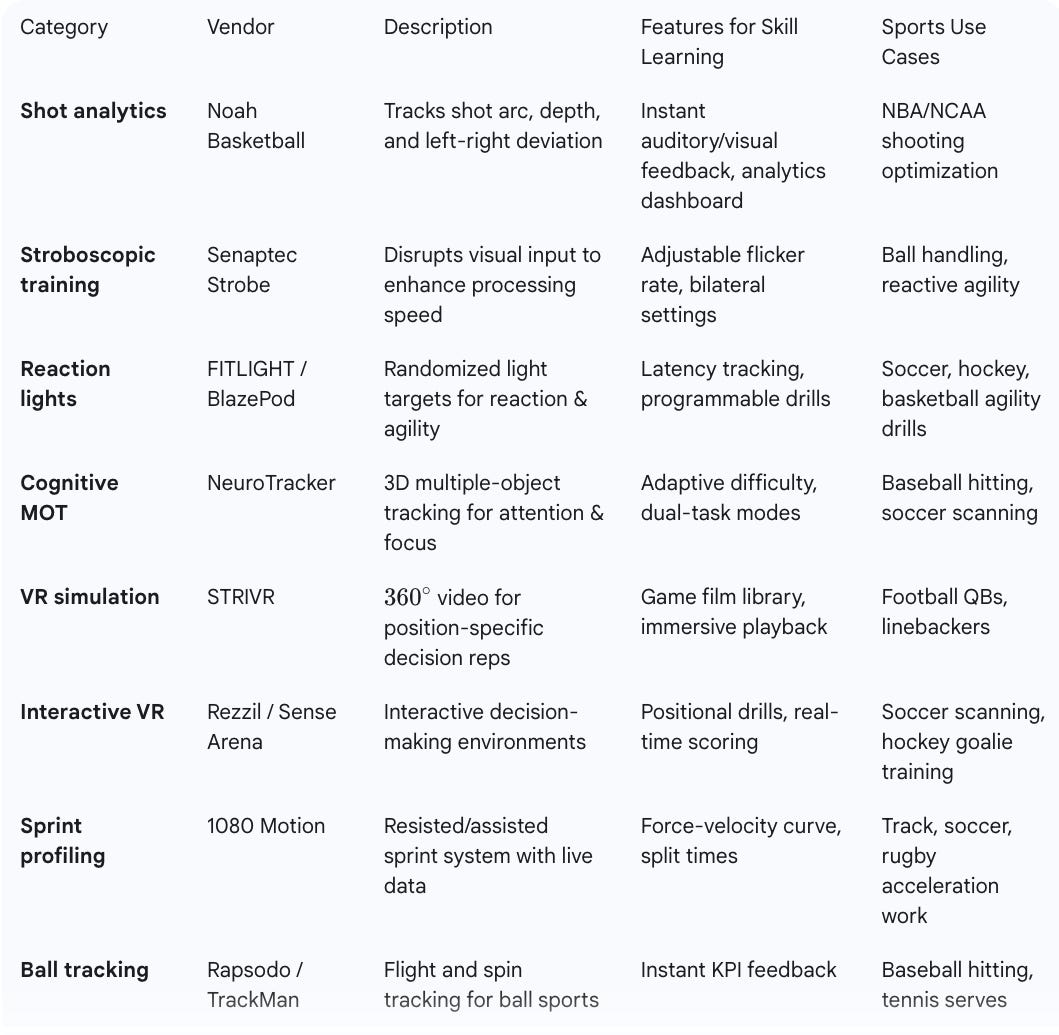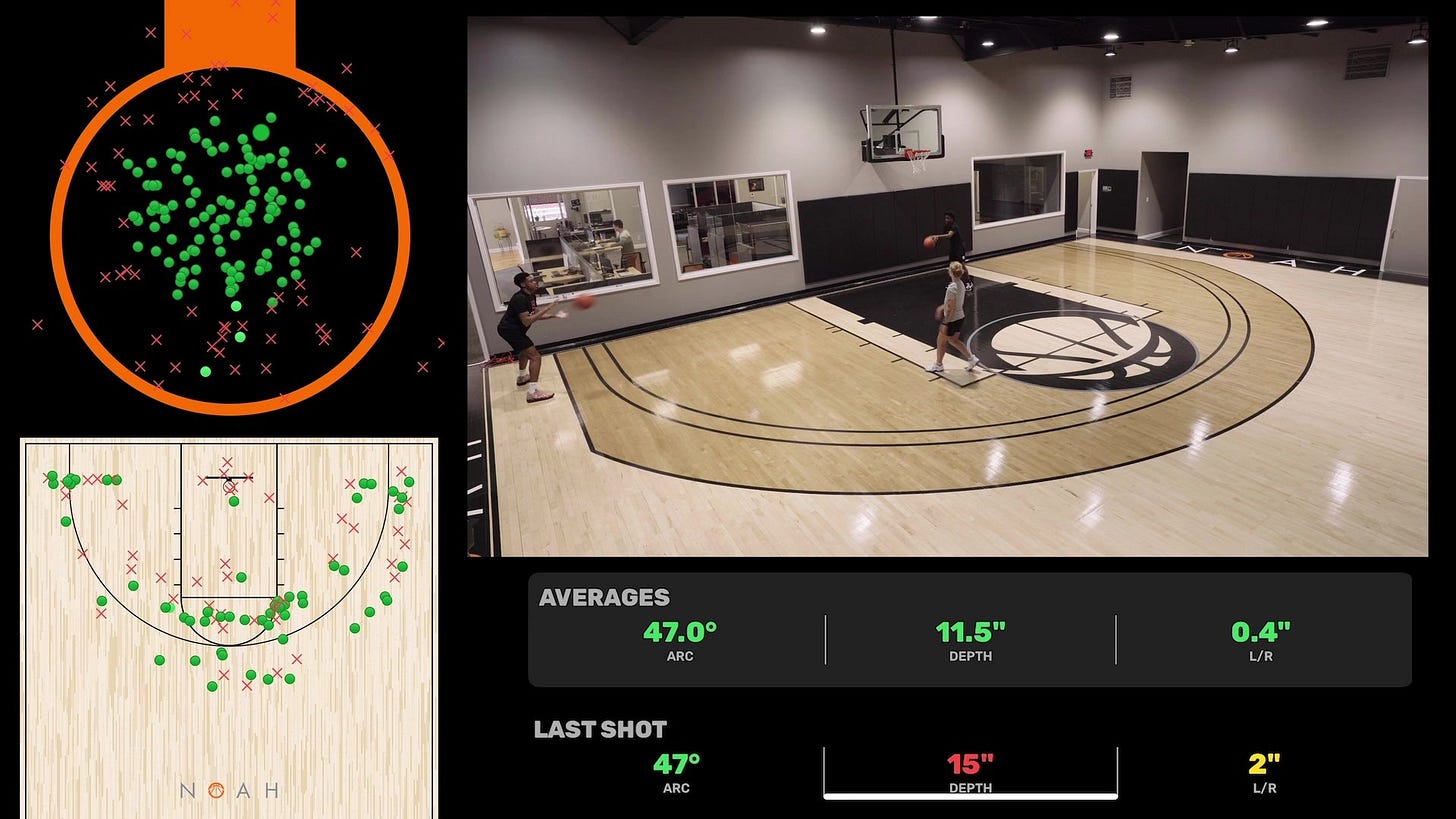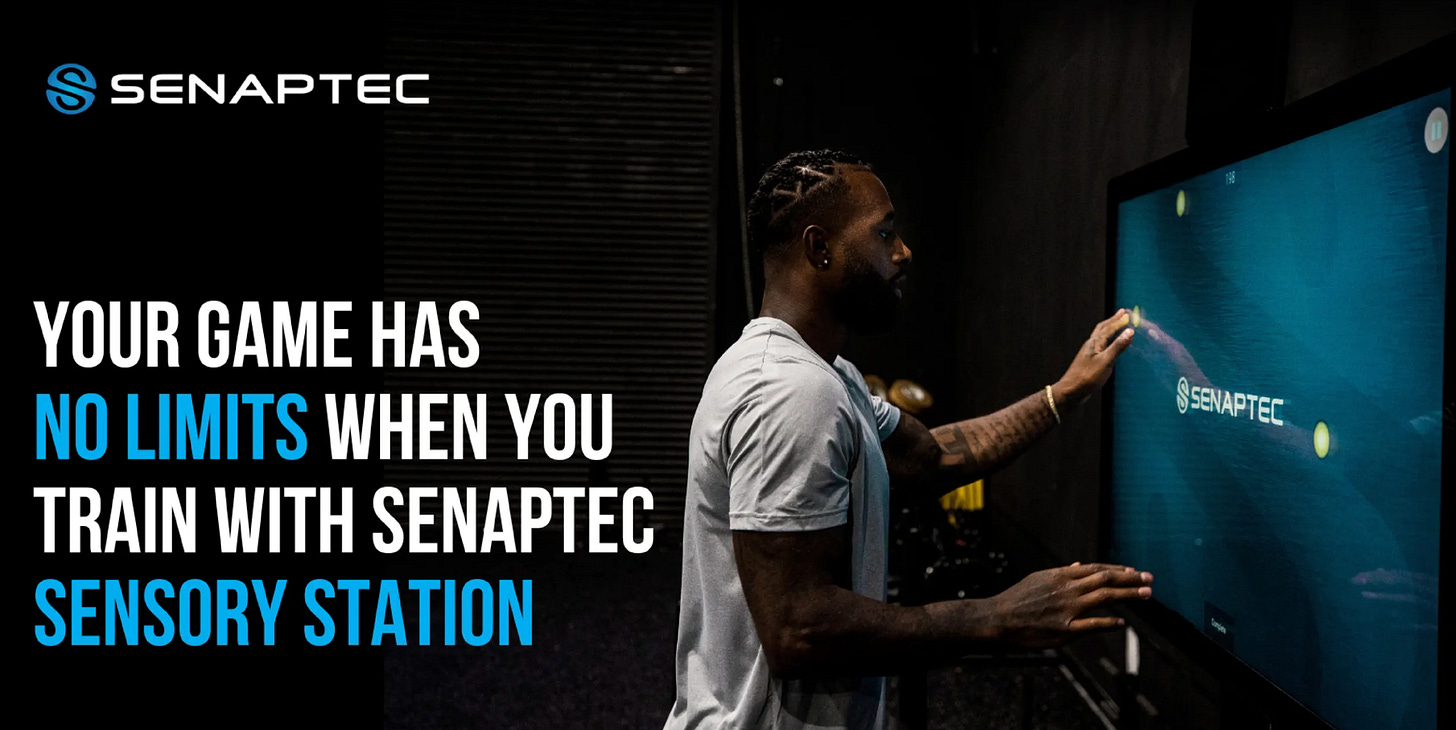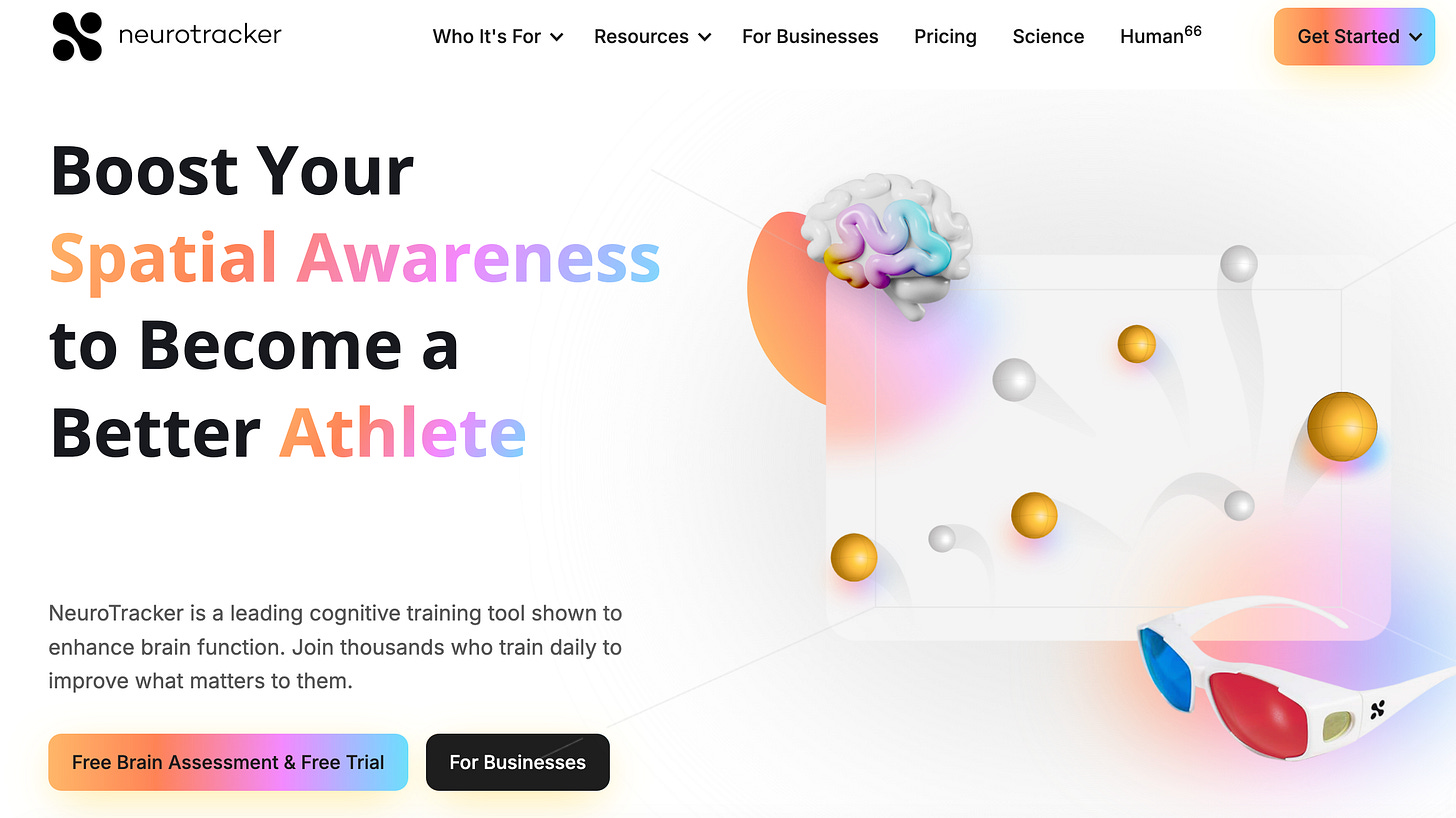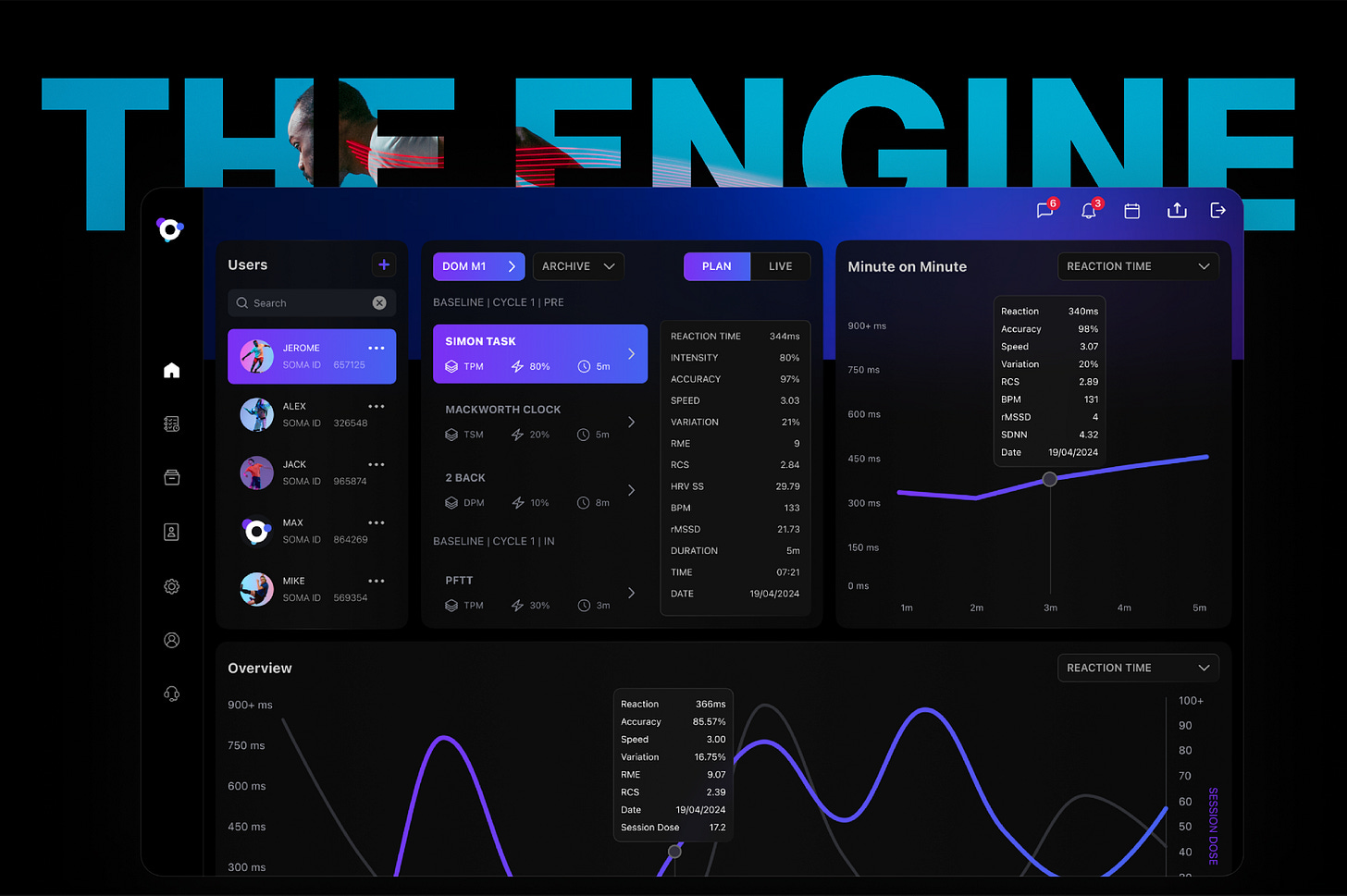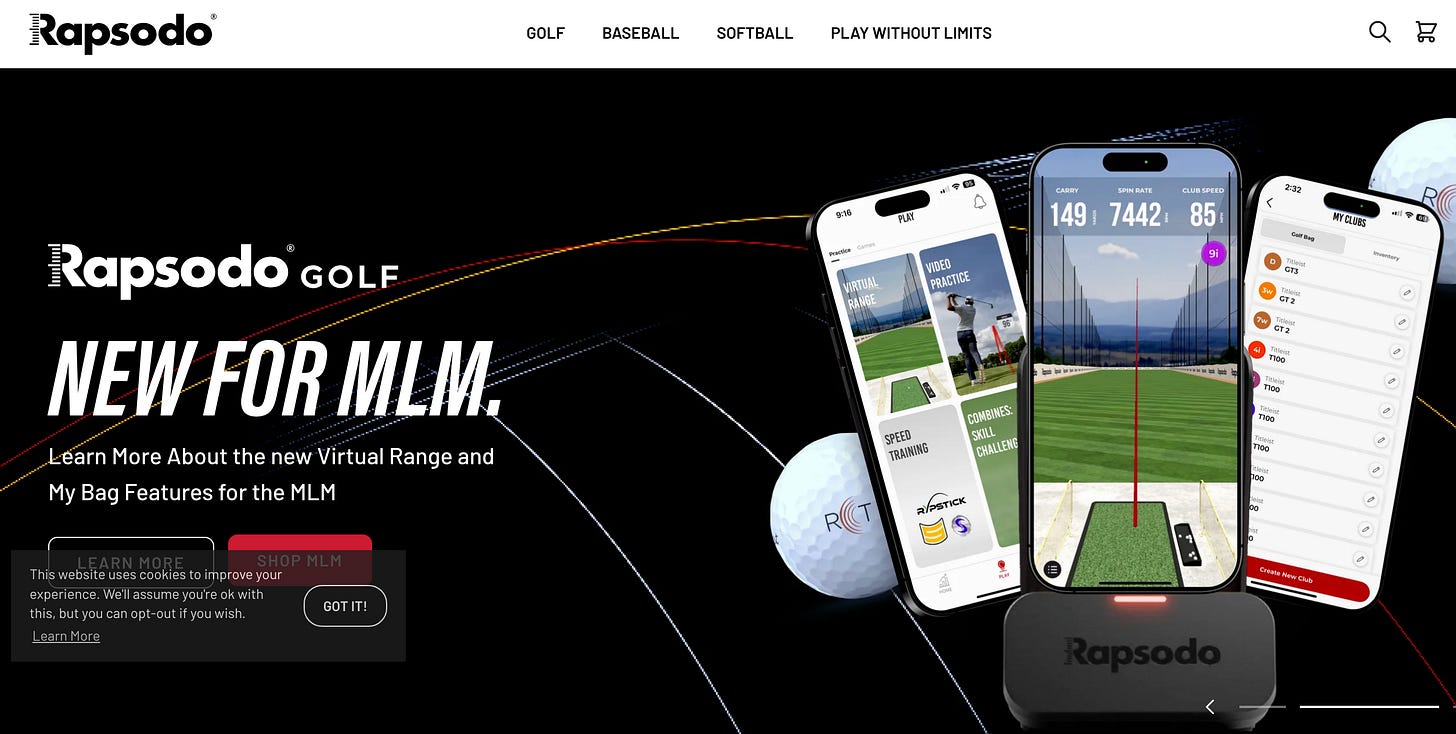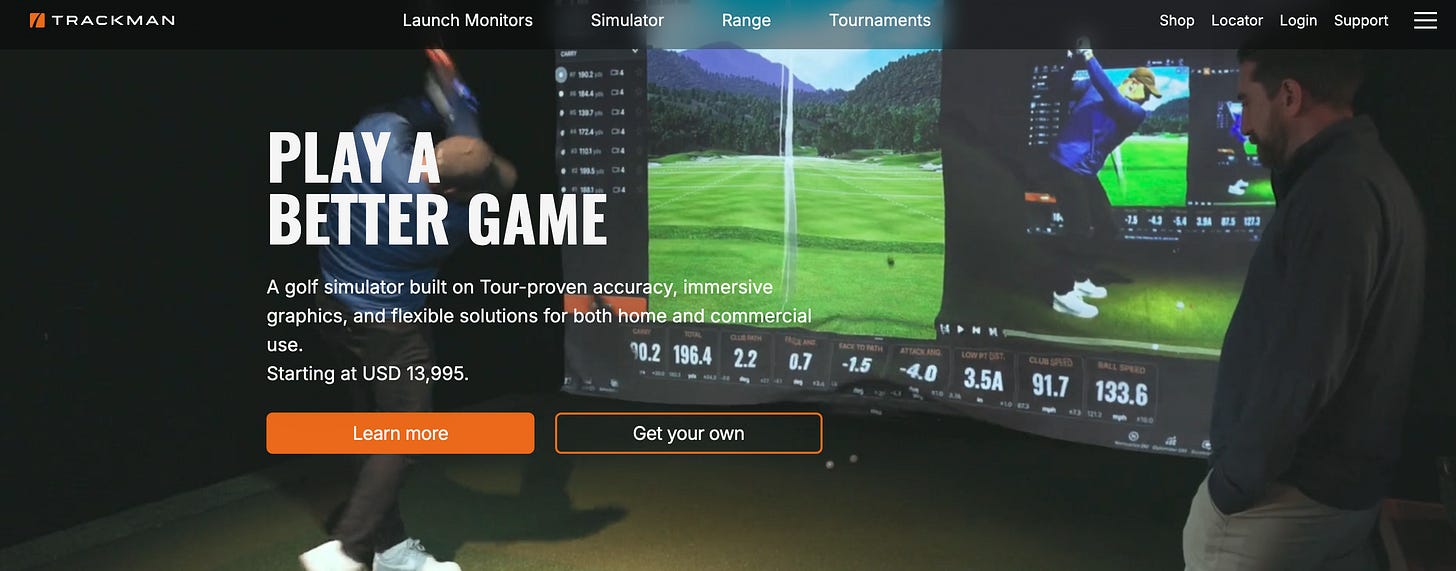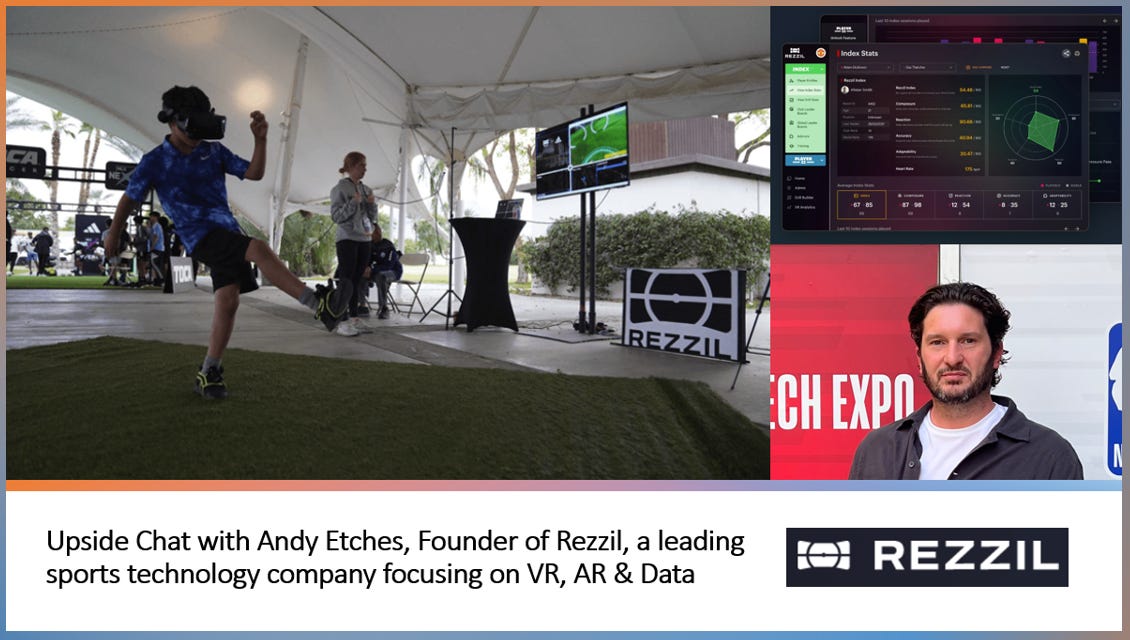📚 Upside Analysis: Skills Acquisition in Elite Sports: The Next Competitive Edge: Key Studies, Stats, Vendors, Methods, Recommendations to Teams
In elite sports, the margin between winning and losing often comes down to milliseconds of reaction time, degrees of movement precision, or the ability to adapt to unpredictable game situations. Over the last decade, sports science has revolutionized physical preparation—load management, recovery protocols, nutrition, and biomechanics. Now, attention is shifting to skills acquisition as the next frontier.
Skill acquisition isn’t just about repetition—it’s about representative learning design, decision-making under pressure, and developing adaptable athletes who can solve complex problems in real time. This shift is changing how teams design practice, select technology, and evaluate performance.
In an environment where competitive edges are short-lived, the focus is moving away from simply measuring what happened to engineering practice environments that guarantee better future performance. Skills acquisition is becoming the strategic lever that links science, coaching, and technology into one system.
Methods for Skill Acquisition Among Elite Teams
1) Constraints-Led Approach (CLA)
CLA focuses on manipulating constraints—task, environment, and player—to guide athletes toward desired solutions without explicit instructions. For example:
Reducing space for midfielders in soccer to force faster scanning and passing.
Adding an extra defender in basketball 3v3 to create overload decision-making.
Limiting the number of dribbles to promote off-ball movement.
The beauty of CLA is that it mirrors the chaos of competition while still targeting specific learning outcomes. Research shows skill transfer is strongest when training conditions closely resemble match scenarios in terms of perception-action coupling.
2) Representative Learning Design (RLD)
RLD is about preserving the informational richness of real games in practice drills. Instead of static cone dribbling, a soccer winger might practice crossing with defenders actively trying to block and attackers timing runs—because that’s what the game demands.
Teams use match analysis to identify the specific patterns, cues, and decisions athletes face, then build drills that replicate them. This prevents the common problem of “practice heroes” who excel in isolated drills but struggle in competition.
3) Small-Sided Games (SSGs)
SSGs remain one of the most effective methods for blending tactical, technical, and physical training:
Adjust pitch size to change running demands.
Change player numbers to alter passing options and defensive coverage.
Modify scoring rules to promote certain behaviors (e.g., 3 points for a goal scored after X passes).
By designing SSGs with intention, coaches can simultaneously overload decision-making and condition athletes in a game-like environment. GPS and heart-rate data now allow precision tuning of intensity and decision density.
4) Differential & Variable Practice
Instead of repeating the same movement in perfect form, athletes practice a family of variations—different speeds, angles, and conditions—so they can adapt in competition.
Quarterbacks throwing with altered arm slots.
Tennis players serving with varied toss locations.
Basketball players shooting after contact or under fatigue.
Variable practice introduces “desirable difficulties” that slow learning in the short term but improve retention and transfer.
5) Perception–Cognition Training
At the elite level, decision-making speed is often more decisive than raw physical ability. Perception–cognition training focuses on:
Picking up relevant cues earlier (e.g., reading a pitcher’s hand position).
Filtering irrelevant information faster.
Linking recognition directly to movement execution.
Tools like stroboscopic eyewear, multiple-object tracking, and occlusion drills are increasingly being blended into physical training rather than used in isolation.
6) Feedback-Rich Repetition
Repetition without feedback risks reinforcing bad habits. Modern elite practice designs integrate immediate, actionable feedback:
Basketball players hearing an audio cue if their shot arc falls outside the optimal range.
Soccer strikers receiving instant shot placement metrics from ball-tracking tech.
Sprint athletes seeing real-time force and velocity curves on a display.
The principle: the faster the feedback, the faster the adaptation.
7) Immersive Simulation (VR/AR/360°)
Simulations allow athletes to multiply decision reps without physical wear and tear:
Quarterbacks reviewing dozens of defensive coverages in a single VR session.
Hockey goalies reading breakaways in a virtual rink.
Soccer midfielders practicing scanning patterns in VR match footage.
This technology is especially valuable for athletes recovering from injury, enabling them to stay sharp cognitively.
Key Stats
Here are some key statistics and data points related to skills acquisition in elite sports, complete with their sources. These statistics often highlight the measurable differences between elite athletes and novices.
1. The "10,000-Hour Rule" for Deliberate Practice
This is one of the most famous (and often debated) statistics in the field of expertise. It suggests that a high level of performance in any domain requires at least 10,000 hours of "deliberate practice."
Statistic: Elite violinists had accumulated a minimum of 10,000 hours of deliberate practice by age 20, compared to approximately 8,000 hours for good violinists and 4,000 hours for music teachers.
Source: The Role of Deliberate Practice in the Acquisition of Expert Performance
2. Reaction Time and Anticipation
Elite athletes don't just react faster; they can often anticipate events and make decisions more quickly due to their advanced perceptual and cognitive skills.
Statistic: In a study on cricket batting, expert batters could identify the type of delivery (e.g., fast, medium, slow) up to 200 milliseconds earlier than novice batters, allowing them to initiate their movement sooner.
3. Quiet Eye and Visual Focus
The "Quiet Eye" is a gaze behavior where an expert athlete maintains a steady, final fixation on a specific target or location just before a critical movement, such as shooting a basketball or putting a golf ball. This is a key measure of perceptual expertise.
Statistic: Elite basketball players exhibit a Quiet Eye duration of over 2 seconds, which is significantly longer than novice players, whose Quiet Eye duration is typically less than 1 second. This extended fixation is highly correlated with successful outcomes.
Source: Perceptual-cognitive expertise in sport: a meta-analysis
4. Tactical and Decision-Making Superiority
Elite athletes' expertise extends beyond physical skill to include superior tactical knowledge and decision-making under pressure.
Statistic: Elite athletes in sports like soccer or basketball are able to identify and process relevant tactical information from a game scene up to 500 milliseconds faster than their less-skilled counterparts, leading to more optimal decision-making.
Study: Decision Making in Sport: The Role of Attention, Prioritisation and Memory
Key Studies
Based on your request, here are some top studies and sources on skills acquisition in elite sports. The field is a large one, so these are foundational and highly-cited works that cover a range of key theories and concepts.
1. Deliberate Practice Theory
This is one of the most influential theories in the study of expertise. It suggests that expert performance is a result of extensive, purposeful practice, rather than innate talent. This research is often a starting point for discussions on skill acquisition.
Study: The Role of Deliberate Practice in the Acquisition of Expert Performance
Authors: K. Anders Ericsson, Ralf Th. Krampe, and Clemens Tesch-Römer
Source: Psychological Review, 1993
2. Ecological Dynamics Approach
This perspective offers an alternative to the traditional information-processing model of skill acquisition. It emphasizes the interaction between the individual, the task, and the environment (referred to as "constraints"), arguing that skill emerges from this relationship.
Study: Skill Acquisition in Sport: Research, Theory and Practice
Authors: Nicola J. Hodges and A. Mark Williams
Source: Taylor & Francis eBooks, 2019
3. Perceptual-Cognitive Expertise
This area of research focuses on the mental skills that differentiate experts from novices. It examines how elite athletes process visual information, anticipate opponents' actions, and make quick decisions under pressure.
Study: Expert Performance in Sport: A Cognitive Perspective
Authors: Nicola J. Hodges, Janet L. Starkes, and Clare MacMahon
Source: The Cambridge Handbook of Expertise and Expert Performance, 2023
4. Talent Development
Studies in this area look at the long-term process of becoming an elite athlete, including the pathways, coaching, and environments that support the development of expertise.
Study: Expert performance in sport and the dynamics of talent development
Authors: Elissa Phillips, Keith Davids, Ian Renshaw, and Marc Portus
Source: Sports Medicine, 2010
4. Brain Endurance Training (BET)
The study entitled “Brain Endurance Training Improves Physical, Cognitive, and Multitasking Performance in Professional Football Players” aimed to evaluate whether Brain Endurance Training (BET)—cognitive tasks designed to induce mental fatigue—when added after standard physical training, could improve endurance, decision-making, attention under fatigue, and multitasking skills in professional footballers more than physical training alone.
a. BET Boosted Endurance Despite Preseason Fatigue
IFT Results: BET group maintained endurance performance, while the control group declined—suggesting BET made players more resilient to possible overreaching during intense preseason training.
Possible Mechanism: Adaptations in the anterior cingulate cortex may reduce perception of effort and mental fatigue impact.
b. Cognitive Gains Were Most Evident Under Fatigue
Stroop Test:
BET players improved reaction times by 11% (vs. 4% for control), with accuracy remaining ~94%.
Task was perceived as less mentally demanding and required less effort post-BET.
PVT Results:
In the fresh state: no difference between groups.
In the fatigued state (post-RSA test): BET group had 42% fewer lapses post-intervention, while control group showed no change.
Interpretation: BET appears to enhance inhibitory control and attention when mental resources are depleted—critical during late-game situations.
c. Multitasking Performance Improvements Were Substantial
RSA Directional Phase: BET players were significantly faster in responding to directional cues after sprints.
S-RAG:
BET players improved times by 8.9%, vs. 4.3% in control.
Errors dropped 69% for BET, vs. 21% for control.
Practical Relevance: Enhanced ability to process visual information and make quick, accurate decisions while fatigued could directly impact match performance in defensive and attacking transitions.
Key Stats and Impact of Skills Acquisition
1. Borussia Dortmund – Footbonaut
The Footbonaut is a $2–3.5 million high-tech football training system—a 14×14 meter cage with ball-launchers and 72 light-up panels—that fires balls at players from different angles and speeds, requiring them to quickly control and pass into designated targets. It develops reaction time, awareness, passing accuracy, and scanning skills while tracking performance data.
Borussia Dortmund uses it extensively across its academy (U9–U19) for 30–60 minute weekly sessions, giving players up to 60 touches per minute compared to about 60 in a full normal training session. It’s also used for rehab with senior players, standardized testing, and cognitive training, with data helping coaches benchmark and spot technical or perceptual weaknesses. By combining it with tools like VR “Be Your Best,” Dortmund creates a broader innovation ecosystem, making the Footbonaut a central part of player development, skill refinement, and recovery.
2. Noah Basketball – NBA Adoption
Noah Basketball is a cutting-edge shot-tracking system installed in NBA, NCAA, and high school gyms that captures every shot's arc, depth, and left/right deviation 30 times per second using overhead sensors—then delivers instant verbal feedback (“Noahlytics”) to help players build muscle memory and refine their jumpER (Source here)
Used by over 90 percent of NBA teams (26–28 of 30), it's become a staple in professional shooting development. The system auto-tags shots (even recognizing players via facial recognition), logs video clips, and provides detailed analytics—enabling coaches to track shooting consistency, diagnose flaws, and tailor sessions for individual players. It played a pivotal role, for example, when the Raptors used Noah to correct Kyle Lowry’s flat shooting arc during a slump, simply by turning on the system's arc feedback setting and letting him retrain over a few days (Source: CNBCReddit). In summary, Noah Basketball provides real-time cueing, data-driven insights, and shot-by-shot analytics that NBA teams leverage to accelerate shooting improvement and strategic development in ways previously only possible through guesswork.
3. Senaptec Strobe – 8-Week Training Study
The Senaptec Strobe is a pair of training glasses that use liquid crystal lenses to intermittently block vision in varying patterns and speeds, forcing athletes to process information more efficiently, sharpen reaction time, and enhance hand-eye coordination under reduced visual input. By challenging the brain’s visual and cognitive systems, it strengthens focus, anticipation, and decision-making in high-pressure environments. Professional teams across the NBA, NFL, NHL, MLS, and NCAA integrate the Strobe into drills for shooting, passing, catching, and defensive reads—helping players adapt faster, reduce reliance on constant visual cues, and perform more instinctively. It’s also used in rehabilitation settings to retrain visual-motor skills after concussions or injuries, making it a versatile tool for both peak performance and recovery.
AVEH Journal peer-reviewed article: “A profile of Senaptec Strobe on functional balance in football players (Source here)
BMC Sports Science (volleyball, 6-week program): “Effects of six-week stroboscopic training…” (Source: BioMed Central)
4. NeuroTracker – Pro Baseball Hitting Study
NeuroTracker is a 3D multiple-object tracking system that challenges athletes to process complex visual information quickly under pressure, simulating the split-second demands of hitting a baseball. In the study, players who trained with NeuroTracker showed measurable improvements in batting metrics, including strike zone discipline and contact rates, highlighting the link between cognitive sharpness and on-field performance. Today, several MLB teams integrate NeuroTracker into their player development programs, using it not only for hitters but also for fielders and pitchers to improve focus, situational awareness, and mental resilience, ultimately aiming to give players a competitive edge in high-stakes environments.
Alternative summary (journal-digitallife.com): (Source: Digital Life)
5. STRIVR VR – QB Training
STRIVR Lab is a virtual reality (VR) training platform originally developed at Stanford that immerses athletes in realistic game-like scenarios to accelerate learning and decision-making without physical wear and tear. NFL teams use STRIVR to give quarterbacks, linemen, and defensive players the ability to review plays, read defenses, and improve reaction times in a controlled VR environment. By replaying and experiencing real game footage in 360 degrees, players can mentally rehearse repetitions that would otherwise be limited on the practice field, helping reduce cognitive errors on game day. Beyond skill acquisition,
STRIVR is also used for injury rehabilitation, allowing athletes returning from injury to stay mentally sharp, and for onboarding new players to quickly learn complex playbooks. Many NFL franchises see it as a way to maximize limited practice time while giving their athletes a “mental gym” to strengthen football IQ and situational awareness.
“Fortune” article on NFL VR adoption: (Source: Fortune)
Wired feature: “STRIVR Labs and Stanford Look to Build VR Football Future” (Source: WIRED)
HogsHaven story (NFL Rookie of the Year VR edge) — Jayden Daniels and Cognilize VR training: (Source: Hogs Haven)
Case Studies
Borussia Dortmund – Footbonaut
This 14m-square robotic passing system fires balls to players at varying speeds and trajectories. Players must control the ball and pass it into a lit target as quickly as possible. Dortmund integrates this tech for first touch, scanning, and quick decision-making, particularly for youth and return-to-play athletes.
Golden State Warriors – Noah Analytics
Warriors shooters receive instant auditory feedback during practice on shot arc and depth. Coaches can tailor drills so that feedback is embedded within game-like scrimmages, not just solo shooting.
Stanford Football & NFL QBs – STRIVR VR
Originally developed at Stanford, STRIVR allows quarterbacks to stand “inside” 360° film of their own plays, processing blitzes, coverages, and movement patterns repeatedly without risk of injury.
New Jersey Devils – Sense Arena VR
Goalies train in simulated game scenarios, reading shots through traffic and making split-second saves. This is paired with video analysis and on-ice practice to ensure skill transfer.
Technologies That Enable Skill Acquisition
Source: Upside Global, confidential, August 2025
Noah Basketball
Noah Basketball provides advanced shot analytics by tracking arc, depth, and left-right deviation, offering real-time auditory and visual feedback. Widely used across NBA and NCAA programs, it has become a key tool for optimizing shooting consistency and mechanics.
Senaptec Strobe
Senaptec’s stroboscopic eyewear disrupts visual input to enhance an athlete’s processing speed and decision-making under pressure. Adjustable flicker rates and bilateral training modes make it versatile for sports like basketball, soccer, and hockey that rely on fast perception-action coupling.
FITLIGHT
FITLIGHT use programmable light pods as randomized stimuli for agility, reactivity, and coordination drills. Both systems are lightweight, portable, and highly adaptable for team or individual training, popular in soccer, hockey, and basketball.
BlazePod
BlazePod is a light-based reaction training system that uses portable pods to create drills designed to improve speed, agility, coordination, and decision-making under pressure. The pods light up in customizable sequences, prompting athletes to react quickly with touches, movements, or specific actions, making training both measurable and engaging. Professional teams across sports, including soccer, basketball, and the NFL, use BlazePod to sharpen reflexes, enhance footwork, and simulate game-like reaction demands. In elite settings, it’s often integrated into warm-ups, recovery sessions, and position-specific drills to boost cognitive-motor performance. For example, basketball players use it to train hand-eye coordination and reaction speed when defending, while soccer teams use it for agility and peripheral awareness. Coaches also leverage BlazePod’s data tracking to evaluate performance, monitor progress, and personalize training, making it a versatile tool for both physical and cognitive skill development.
NeuroTracker
NeuroTracker is a cognitive training platform that challenges attention, working memory, and situational awareness through 3D multiple-object tracking tasks. With adaptive difficulty and dual-task modes, it is used by baseball hitters, soccer players, and even military pilots to sharpen focus under pressure.
STRIVR
STRIVR specializes in VR simulation using immersive 360° video to replicate position-specific decision-making scenarios. Originally pioneered in the NFL, it has expanded across multiple sports and industries as a way to accelerate tactical learning through mental reps.
Rezzil / Sense Arena
Rezzil and Sense Arena deliver interactive VR training that combines positional drills with real-time scoring and feedback. These platforms are used in soccer for scanning and decision-making, as well as in hockey for goalie training, bridging the gap between cognitive and technical practice.
Soma
Soma Analytics is a cloud-based neural engine. It forms the core of the Soma ecosystem, seamlessly integrating with Soma NPT to give coaches, clubs, and organizations unparalleled control over cognitive performance.
Mental fatigue monitoring—so you know when performance is about to crash before it happens.
Concussion assessment with hard data—because “looks fine” isn’t a diagnosis.
Cognitive optimization under fatigue—so your athletes train their brains like they train their bodies.
Cognitive priming to accelerate neural and physical readiness—ensuring athletes start every session mentally locked in and physically primed for peak performance.
Soma NPT is a mobile cognitive training system. It builds decision-making speed, reaction time, and mental endurance, anytime, anywhere. No lab conditions. No guesswork. Just real-world cognitive training that adapts as athletes improve.
No clunky equipment. No fixed locations. Cognitive training should be as adaptable as the athlete.
Seamless integration with Soma Analytics, giving you real-time data on cognitive resilience, mental fatigue, and decision-making performance.
A full-spectrum cognitive training system that evolves with your athletes.
1080 Motion
The 1080 Sprint system provides resisted and assisted sprint training with precise live data on force, velocity, and split times. Considered a gold standard for sprint profiling, it is widely used in track & field, soccer, and rugby to individualize acceleration development.
Rapsodo / TrackMan
Rapsodo and TrackMan specialize in ball-tracking technologies that measure spin, flight path, and velocity, delivering instant KPI feedback. These systems are staples in baseball and tennis for refining hitting, pitching, and serving performance. https://trackman.com
Footbonaut
The Footbonaut is a robotic training cage that delivers balls from multiple angles and requires players to control and pass quickly toward illuminated targets. Used at Borussia Dortmund, it has become a benchmark innovation for developing first touch, scanning, and passing accuracy in soccer.
The Quick Board
The Quick Board is a reactive training and assessment system that uses an electronic touch-sensitive board paired with visual cues to measure and improve athletes’ foot speed, reaction time, coordination, and agility. It provides immediate feedback and detailed data analytics, allowing coaches to assess neuromuscular control, symmetry, and cognitive processing under pressure. Professional teams in the NFL, NBA, MLS, and NCAA programs use The Quick Board to design drills that replicate sport-specific movement patterns, helping athletes enhance quickness, explosiveness, and decision-making. It is also widely applied in rehabilitation settings, where practitioners use the system to track progress after injury and ensure athletes regain speed and balance before returning to play. By combining physical training with cognitive demand, The Quick Board helps teams maximize performance while reducing injury risk.
SkillCourt
SkillCourt is an interactive digital training platform that combines a motion-tracking floor with visual cues to enhance speed, agility, coordination, and cognitive processing in athletes. The system projects lights and patterns onto the floor, prompting players to react with precise movements, integrating physical performance with mental decision-making. Elite teams across soccer, basketball, and hockey use SkillCourt to train peripheral vision, reaction speed, and multi-tasking under game-like pressure, while also collecting objective data to track progress. Beyond performance, SkillCourt is applied in return-to-play protocols and rehabilitation, giving practitioners a way to challenge athletes’ cognitive-motor skills in a safe, controlled environment. By merging agility training with brain training, SkillCourt helps athletes build sharper game awareness and faster decision-making on the field.
How Skills Acquisition Helps Leverage Technology Data
Closing the Loop – Match analysis shows where breakdowns happen; skill acquisition methods recreate those situations in practice with embedded feedback.
Personalization – Data from wearables, ball tracking, and GPS tailors constraints to each athlete’s needs.
Skill KPIs as Readiness Metrics – Instead of only physical metrics (e.g., sprint speed), skill metrics (e.g., scan rate, decision accuracy) can gate return-to-play decisions.
Faster Feedback Cycles – Integrating tech means coaches can adjust drills in real-time rather than waiting for post-session reports.
Non-Tech Approaches
Beyond devices, elite teams also rely heavily on constraint-led training and game-like practice designs. Small-sided games, for example, are a staple in football, basketball, and rugby to foster decision-making and tactical adaptability in chaotic environments. Constraint manipulation—such as adjusting pitch size, altering rules, or setting asymmetric scoring—encourages creativity and problem-solving. Differential learning, where athletes are deliberately exposed to variability (different surfaces, ball types, or fatigue conditions), broadens motor adaptability. Mental training—through visualization, scenario walkthroughs, or peer teaching—adds another layer of skill acquisition without physical overload. These approaches ensure skills are not just learned in sterile drills but in dynamic, pressure-filled contexts that replicate real competition.
Organizational-Level Skill Acquisition Methods in Elite Sports
Skill acquisition in elite sport does not only depend on the tools or drills an athlete uses, but also on how an organization structures its learning environment. Leading teams treat skill development as a system-wide priority that spans from academies to senior squads. Key organizational methods include:
Player Pathway Integration
Top clubs design aligned curriculums across youth, reserve, and first teams so that athletes progress through consistent skill acquisition frameworks. For example, Ajax and Barcelona emphasize positional play concepts (“Juego de Posición”) across all levels, ensuring seamless transitions.
This allows a 16-year-old academy player to enter the first team with tactical and technical skills already embedded.
Interdisciplinary Collaboration
Performance staff (sport scientists, S&C coaches, psychologists) work closely with technical coaches to embed skill acquisition principles into daily practice design.
For example, cognitive training might be paired with conditioning drills, or tactical walkthroughs might be layered with skill micro-doses for efficiency.
Learning Culture & Coach Development
Organizations that emphasize continuous learning—both for athletes and staff—tend to see more sustainable gains.
This includes regular coach education in skill acquisition science, plus creating an environment where players are encouraged to experiment, fail, and adapt.
Liverpool FC under Jürgen Klopp is known for its error-tolerant learning culture, allowing players to make mistakes in training to accelerate tactical and technical mastery.
Deliberate Variability Across the Season
Elite organizations plan training across the calendar to expose athletes to different conditions, tactical shapes, and stressors.
This organizational approach ensures that athletes develop adaptability—key for competing across domestic leagues, international tournaments, and congested schedules.
Data-Driven Feedback Loops
Organizations increasingly use centralized data hubs to collect, compare, and feedback skill acquisition progress across squads.
For example, as mentioned above, NBA teams log shooting arc data from Noah across both training and games, then integrate it into team-wide performance reviews that influence scouting, player development, and load management.
Cross-Context Training (Transfer of Skills)
Some teams deliberately design multi-sport or cross-skill exposures to accelerate motor learning.
Examples include rugby players using small-sided futsal for agility and passing perception, or baseball teams using visual occlusion training from soccer to improve batting reaction times.
Organizational Investment in Facilities & Innovation Labs
As mentioned above, many elite organizations are creating dedicated skill acquisition labs—such as Footbonaut facilities in German football or VR performance suites in NBA and EPL clubs.
These investments institutionalize skill acquisition as part of the club’s identity rather than an add-on.
✅ The big takeaway: At the organizational level, skill acquisition is less about drills and more about culture, structure, and alignment. The most successful teams institutionalize skill learning across pathways, coach development, and data-driven systems, ensuring that every layer of the organization contributes to athletes’ ability to perceive, decide, and execute under pressure.
Future Trends in Skills Acquisition
AI-driven adaptive drills: Systems that modify constraints mid-drill based on live athlete performance metrics.
Opponent-specific simulations: VR and AR sessions built directly from tracking data of upcoming opponents.
Integration of eye-tracking: Scan behavior becoming a standard performance KPI in soccer, hockey, and basketball.
Skill-load management: Just as teams track physical load, they’ll track “decision load” and schedule recovery for cognitive fatigue.
Shared skill databases: Multi-team data pools for benchmarking skill KPIs across leagues.
Mixed-reality facilities: Full-sized practice environments with augmented overlays for decision-making cues.
Recommendations to Teams
Hire or train a Skill Acquisition Specialist to bridge coaching, analytics, and sports science.
Embed feedback into representative tasks, not isolated drills.
Use tech as an amplifier, not a crutch—if the drill design is poor, data won’t save it.
Track both physical and cognitive load to balance decision-making demands with recovery.
Audit skill transfer quarterly by comparing practice KPIs to in-game outcomes.
Invest in scalable tools so skill acquisition is part of everyday training, not an occasional experiment.
Conclusion
In elite sport, physical preparation is table stakes—decision-making speed, adaptability, and execution under pressure now define the cutting edge. Skills acquisition offers the framework to systematically build these qualities, especially when fused with modern technology and data. The teams that integrate it deeply into their culture will not only train harder, but train smarter, turning practice into a direct pipeline to game-day success.
You may also like:
🔥Upside Chat: Kevin Martin, CEO, The Quick Board, A Leading Visual Training and Rehab Technology Company.
This week, we have the honor to interview Kevin Martin, CEO of The Quick Board, that developed a visual training and rehab technology.
🔥🥽Upside Chat: Upside Chat with Andy Etches, Founder of Rezzil, a Leading Sports Tech Company Focusing on VR, AR and Data.
This week, we have the honor to interview Andy Etches, Founder of Rezzil, a leading sports technology company focusing on VR, AR and data.
🧠Upside Chat with Christian Hasler, Managing Director/ Co- Founder, SKILLCOURT GmbH, A Leading Sports & Health Tech Company.
Today we have the honor of interviewing Christian Hasler, Managing Director/ Co- Founder, SKILLCOURT GmbH, a leading sports and health tech company.


